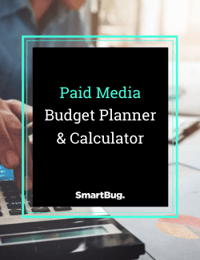
When launching your very first paid search campaign using Google Ads, getting your text ads to stand out can seem like a daunting task. In the deep ocean that is Google’s search engine results page (SERP), you have only a split second to grab someone’s attention with an eye-catching headline or enticing call to action (CTA).
Luckily, Google has equipped paid search experts with one more tool to help build a successful campaign: ad extensions!
What are Google Ad extensions?
Okay, but what exactly is an ad extension? Google Ad extensions are additional pieces of information that can be added to your search ads that are complementary to your main headlines and descriptions. Implementing ad extensions to your Google Search campaign is not only a great way to help your ads stand out, but it also helps with the overall optimization of your pay-per-click (PPC) campaign.
I’ve always liked to think of ad extensions as the icing on the cake of your search campaigns. Sure, the cake itself implies that it’s someone’s birthday, but the icing provides very important additional information that is fundamental to the overall message. How else would you know to wish Frank a happy birthday?
Why should I use Google ad extensions?
We’ve talked about what an ad extension is, but you may still be asking yourself why they’re so important to implement as part of your PPC campaign. Here are our top five reasons why you should include ad extensions as part of your paid search optimization strategy:
1. Circumvent that pesky ad character limit.
With only three 30-character headlines and two 90-character descriptions per text ad, getting your entire message across can sometimes be difficult. Ad extensions provide avenues for additional information that you may not be able to fit in otherwise. This can provide additional context to your ads or even communicate additional benefits of your product or service that you couldn’t cover in the first 270 characters!
2. Increase ad relevance.
While Google’s search algorithms have evolved a lot over the years, one thing has remained consistent for the past several years: Content relevance is king! As is true with organic search and paid search alike, the more relevant your content is to each individual search query, the higher you will rank.
Because Google’s responsive search ads are optimized to show the most relevant combination of headlines, descriptions, and ad extensions on every auction, implementing all ad extensions that could be relevant to your customers will increase the chance that your ad will outbid your competitors. For instance, if you’re targeting local customers, a location extension may help drive traffic to your physical location or Google Maps listing!
3. Increase ad rank.
Remember when we said that content relevance was king? Google’s goal is to provide the best experience possible for its users, which is why quality content will always outrank content that is less than stellar.
Ad extensions factor into your overall Ad Rank alongside other factors such as the quality of your ads and landing page, the context of a user’s search, Ad Rank thresholds, and your overall bidding strategy. The additional information that ad extensions offer typically leads to a higher overall prominence of your ads.
The more prominent your ads using extensions become, the more ad extensions will affect your Ad Rank in the future. Sounds like a win to us!
4. Control your CPC cost.
What comes alongside an increased Ad Rank, you ask? As you may guess, a higher Ad Rank typically results in a low overall CPC cost per auction.
Implementing ad extensions offers a great opportunity for controlling your CPC costs without having to increase your budget. Implementing ad extensions is also a more cost-effective way to increase your clicks and conversions instead of raising your maximum bid. Higher relevance and a lower cost—what could be better?
5. They’re free!
The final (and arguably most important) reason to implement ad extensions is the simple fact that they are free. Yes, you heard that right. No three easy installments of $19.99, because they’re F-R-E-E! Ad extensions are available as a free optional feature within any Google Ads campaign, and they’re extremely beneficial to creating an effective CPC campaign.
When do ad extensions show?
Something to keep in mind after deciding to add extensions to your Google Ads campaign is that simply enabling them does not necessarily mean that they will always show when your ads are displayed. Just as responsive text ads will display the headlines and descriptions that Google’s algorithms see as most relevant to each user, there are certain criteria that dictate when each ad extension is displayed.
One of these factors is whether or not your ad rank is high enough for extensions to be displayed. Your ad rank also plays into your ad’s position, which has an influence on whether or not your extensions are displayed. There is limited space on the Google SERP, and the ads with the highest ad rank and priority tend to be allocated the most real estate.
Of course, relevance also is arguably the most important factor in whether or not your ad extension shows. Extensions are more likely to display if they are expected when they are predicted to increase performance.
What types of ad extensions are available?
Now that you know all the benefits that ad extensions bring, it’s important to understand all the different shapes and sizes in which they appear. Google offers a wide variety of different types of ad extensions, and choosing the types that are most appropriate for your company will be vital for implementing a successful strategy.
First of all, ad extensions can be broken down into two main categories: automated extensions and manual extensions.
Whereas manual extensions must be set up by you or your paid media manager, automated extensions are added to your ads automatically when Google’s algorithms find information that is expected to increase ad performance. The information used for these automated extensions is typically taken directly from your website or other highly credible sources.
Here is a quick list of all types of automated and manual extensions that Google currently offers:
Manual Extensions
- Call: Encourages users to call your business by adding a phone number.
- Location: Integrates with your Google My Business profile and encourages users to visit your physical location by displaying your location, a call button, and a link to your business details page.
- Affiliate Location: Helps users find a local retail store that sells your products.
- Callout: Adds additional text to your ads that emphasize certain features such as “free delivery,” “24/7 customer support,” and so on. Ideal for campaigns encouraging offline conversions.
- Sitelink: Link directly to key pages on your website.
- Structured Snippet: Allows you to display information about specific products or services. Acts as a sort of mini text ad with a headline and description.
- Price: Showcase pricing for your product or service catalog directly on your ad.
- App: Encourages users to download your Apple or Android App.
- Image: Allows paid media managers to upload an image that will appear next to your text ad to help it visually stand out more.
- Promotion: Adds specific text that highlights a promotion on your ad.
- Lead Form: Creates the ability for leads to submit a form without needing to click through on a landing page. Uses webhooks to integrate with any customer relationship management (CRM) platform. Hubspot offers native integration when syncing with your Google Ads account.
Automated Extensions
- Dynamic Sitelinks: Helps users get to their intended destination by automatically pulling a link to a page from your website.
- Dynamic Structured Snippets: Includes additional information from your website that gives users a better idea of your product or service offerings.
- Dynamic Callout: Automatically provides additional details about your company from your website.
- Automated Location: Displays your physical location, phone number, and a link to your company details page.
- Affiliate Location: Includes the location of the closest retailer that sells your products.
- Seller Ratings: Displays a seller rating from Google customers reviews or other Google-approved review websites.
Note: Automated extensions are enabled by default. If you would like to disable them, you are able to do so in your Ads and extensions tab.
What are the best ad extensions to use?
Ahhh, decisions, decisions ... Google certainly offers a very wide range of different types of ad extensions to enrich your ad content. With so many options, choosing the ones that best fit your company can be a tricky endeavor.
When trying to decide on which ad extensions to use, think about which would best support your advertising goal and choose the extensions that help you achieve it.
For instance, if you are a restaurant that is trying to drive foot traffic, you may want to add a location extension, a call extension, and a sitelink extension that goes to your online ordering page. This would differ greatly from the strategy that an online retailer might use. For them, it would make more sense to include a price extension, sitelink extensions to their different product categories, and a promotion extension with a free shipping code.
Thinking about your goals and how a user will interact with each extension will help you narrow down a list of the most useful for your company.

About the author
Shawn McFadden Born in a Cleveland Suburb, Shawn was destined to be a marketer ever since pitching his father on a Sony Playstation (True Story)! After spending 6+ years wearing lots of hats at a small agency, he came to SmartBug to show that there were brains under those hats. Formerly a multi-talented Marketing Strategist that was rockin' it for clients across a variety of industries and business types. Read more articles by Shawn McFadden.





















